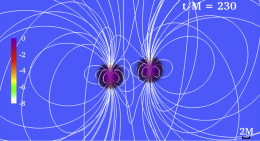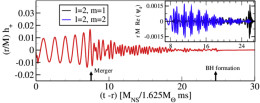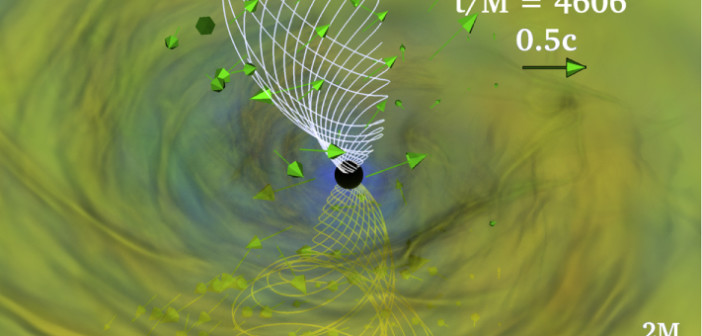With the recent discovery of gravitational waves from the merger of two black holes, it’s especially important to understand the electromagnetic signals resulting from mergers of compact objects. New simulations successfully follow a merger of two neutron stars that produces a short burst of energy via a jet consistent with short gamma-ray burst (sGRB) detections.

Still from the authors’ simulation showing the two neutron stars, and their magnetic fields, before merger. [Adapted from Ruiz et al. 2016]
Challenging System
We have long suspected that sGRBs are produced by the mergers of compact objects, but this model has been difficult to prove. One major hitch is that modeling the process of merger and sGRB launch is very difficult, due to the fact that these extreme systems involve magnetic fields, fluids and full general relativity.
Traditionally, simulations are only able to track such mergers over short periods of time. But in a recent study, Milton Ruiz (University of Illinois at Urbana-Champaign and Industrial University of Santander, Colombia) and coauthors Ryan Lang, Vasileios Paschalidis and Stuart Shapiro have modeled a binary neutron star system all the way through the process of inspiral, merger, and the launch of a jet.
A Merger Timeline
How does this happen? Let’s walk through one of the team’s simulations, in which dipole magnetic field lines thread through the interior of each neutron star and extend beyond its surface (like magnetic fields found in pulsars). In this example, the two neutron stars each have a mass of 1.625 solar masses.
- Simulation start (0 ms)
Loss of energy via gravitational waves cause the neutron stars to inspiral. - Merger (3.5 ms)
The neutron stars are stretched by tidal effects and make contact. Their merger produces a hypermassive neutron star that is supported against collapse by its differential (nonuniform) rotation. - Delayed collapse into a black hole (21.5 ms)
Once the differential rotation is redistributed by magnetic fields and partially radiated away in gravitational waves, the hypermassive neutron star loses its support and collapses to a black hole. - Plasma velocities turn around (51.5 ms)
Initially the plasma was falling inward, but as the disk of neutron-star debris is accreted onto the black hole, energy is released. This turns the plasma near the black hole poles around and flings it outward. - Magnetic field forms a helical funnel (62.5 ms)
The fields near the poles of the black hole amplify as they are wound around, creating a funnel that provides the wall of the jet. - Jet outflow extends to heights greater than 445 km (64.5 ms)
- The disk is all accreted and, since the fuel is exhausted, the outflow shuts off (within 100ms)
Neutron-Star Success

Plot showing the gravitational wave signature for one of the authors’ simulations. The moments of merger of the neutron stars and collapse to a black hole are marked. [Adapted from Ruiz et al. 2016]
While this simulation models milliseconds of real time, it’s enormously computationally challenging and takes months to simulate. The successes of this simulation represent exciting advances in numerical relativity, as well as in our understanding of the electromagnetic counterparts that may accompany gravitational waves.
Bonus
Check out this awesome video of the authors’ simulations. The colors differentiate the plasma density and the white lines depict the pulsar-like magnetic field that initially threads the two merging neutron stars. Watch as the neutron stars evolve through the different stages outlined above, eventually forming a black hole and launching a powerful jet. [Simulations and visualization by M. Ruiz, R. Lang, V. Paschalidis, S. Shapiro and the Illinois Relativity Group REU team: S. Connelly, C. Fan, A. Khan, and P. Wongsutthikoson]
Citation
Milton Ruiz et al 2016 ApJ 824 L6. doi:10.3847/2041-8205/824/1/L6


2 Comments
Pingback: merging neutron stars make jets
Pingback: Simulação de Colisão de Estrelas de Neutrões Reforça Associação com Erupções de Raios Gama de Curta Duração